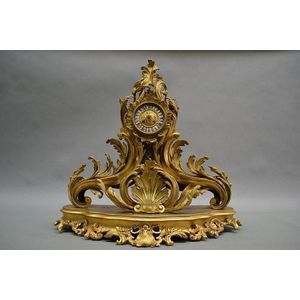Gilt Bronze Inkwell with Semi-Precious Stones
You must be a subscriber, and be logged in to view price and dealer details.
Subscribe Now to view actual auction price for this item
When you subscribe, you have the option of setting the currency in which to display prices to $Au, $US, $NZ or Stg.
- Bronze - An alloy of copper and tin, traditionally in the proportions of about 9 parts of copper to 1 part of tin.
The discovery of bronze in Western Asia in the 4th century enabled people to create metal objects which were superior to those previoulsy possible because of its strength and hardness, and it has been used throughout the world for weapons, coins, tools, statuary and other decorative items.
It is very fluid in a molten state, and its hardness, strength when set, and non-corrosive properties makes it most suitable for casting sculpture. - Malachite - Malachite is bright copper-green coloured stone with concentric layers which displays distinct contrasting veinings. It has been valued in the past for making or decorating small precious objects such as clocks, jewellery, dishes and so. In the Orient it was used for snuff bottles and in Russia and was favoured by the Faberge workshop. larger pieces were used for table tops.
The principal source of supply was Russia but it is to be found in other regions such as Southern Africa, Mexico, Australia and France.
Malachite glass is a manufactured material that was intended to resemble malachite, but often bears more resemblance to a veined coloured marble due to its lower gloss finish and lack of concentric layers. Malachite glass was manufactured by many glassworks in the 19th century including Loetz in Austria and others in Bohemia and Davidson's Greener's and Sowerby in north eastern England.
It was particularly used for scent bottles, bowls, and small vases often decorated with nymphs.
Malachite glass has been manufactured continuously since the late nineteenth century, most is unmarked and it is difficult to distinguish the age or manufacturer of most commercial pieces.
This item has been included into following indexes:
-
ink wells / ink stands, material
- bronze 55
- gold, gilt 47
Visually similar items

A Louis XVI style ormolu bronze figural clock, mid 19th century, the figure of a writer upon a rocky support with a pierced bocage and enclosing the enamel dial with Roman numerals, a white marble plinth below encased in a pierced neoclassical base with ac

Sino-Tibetan gilt bronze figure of Yellow Dzambhala, the BodhisatTVa of Wealth and Abundance cast seated in lalita asana holding the jewel spouting mongoose in his right hand and the conch shell in his left. Height 28.5 cm

Impressive & large antique mid 19th century French gilt bronze clock in the rococo form, standing on a ornate gilt wood base

A pair of garnet drop earrings. 15ct yellow gold. Hook fittings. Weight: 3.55 grams.
